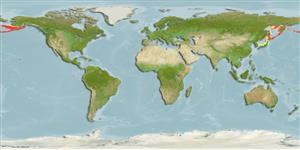Common names from other countries
Environment: milieu / climate zone / depth range / distribution range
Ecologie
; diepteverspreiding 30 - 300 m (Ref. 113219). Temperate, preferred 7°C (Ref. 107945); 60°N - 35°N, 127°E - 150°W
Northern Pacific. From east coast of Korea, Japan and Kamchatka peninsula to Aleutian Islands and Cook Inlet, Gulf of Alaska. Temperate to boreal.
Length at first maturity / Size / Gewicht / Leeftijd
Maturity: Lm ? range ? - ? cm
Maximum depth from Ref. 104115.
Life cycle and mating behavior
Geslachtsrijpheid | Voortplanting | Kuitschieten | Eieren | Fecundity | Larven
Members of the order Decapoda are mostly gonochoric. Mating behavior: Precopulatory courtship ritual is common (through olfactory and tactile cues); usually indirect sperm transfer.
Bisby, F.A., M.A. Ruggiero, K.L. Wilson, M. Cachuela-Palacio, S.W. Kimani, Y.R. Roskov, A. Soulier-Perkins and J. van Hertum. 2005. (Ref. 19)
Status op de Rode Lijst van het IUCN (Ref. 130435: Version 2024-1)
Status bij CITES (Ref. 108899)
Not Evaluated
Not Evaluated
Gebruik door de mens
Visserij: commercieel
FAO - Visserij: landings | FishSource | Sea Around Us
Tools
Meer informatie
Leeftijd/Grootte
Groei
Lengte-gewicht parameters
Lengte-lengte parameters
Morfologie
Larven
Abundantie
Internet-bronnen
Estimates based on models
Preferred temperature
(Ref.
115969): 0.7 - 13.8, mean 2.4 (based on 62 cells).
